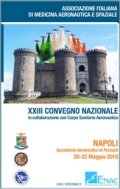




|
|
|
|

Abstract
RESPIRAZIONE A PRESSIONE POSITIVA SU EUROFIGHTER: APPLICAZIONI ED IMPLICAZIONI
Gary William Davies
Royal Air Force, United Kingdom
The new Typhoon aircraft has the ability to reach much greater G-force. Current straining manoeuvres are effective in short periods but become tiring and disabling after prolonged periods, therefore a positive pressure breathing system has been implemented. This project aimed to establish whether short term exposure induced lung inflammation.
Subjects (n=54) were healthy volunteers with no history of respiratory disease. Subjects were allocated to a control group (n=24), a Continuous Positive Airway Pressure group (n=15) at clinical levels or a pressure breathing group (n=19). Pressure breathing was performed at the RAF Centre of Aviation Medicine using a pressure breathing rig, with no additional G-force applied. Subjects wore a chest counter-pressure waistcoat and standard five bladder anti-G trousers to help protect cardiac output, as used by RAF pilots. Physiological monitoring of subjects was performed throughout. Inflammation was investigated using exhaled nitric oxide (eNO), pulmonary function testing and induced sputum analysis for cell counts and cytokines, performed pre and post experimental period.
Results show that there was no significant statistical difference between the pre and post tests in the pressure breathing group for any inflammatory test suggesting that there is no significant sustained lung inflammation. Daily eNO levels suggested that levels peaked during the five days and there was evidence of two groups within the group. These groups had different responses to pressure breathing, one suggesting greater inflammation than the other, though this was not sustained to post day five.
In the CPAP group there was a trend towards a reduction in exhaled nitric oxide and an improvement in residual volume and RV/TLC ratio.
Further studies to look at longer exposure to pressure breathing and involvement of additional G-force are required. Larger studies are also required into exhaled nitric oxide as a biomarker of airway inflammation in these settings.